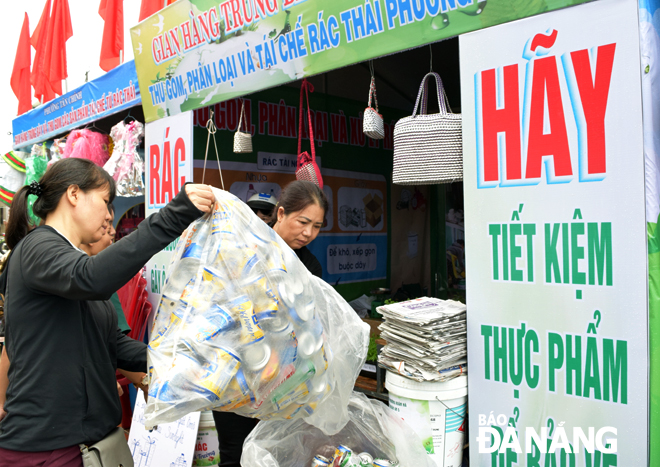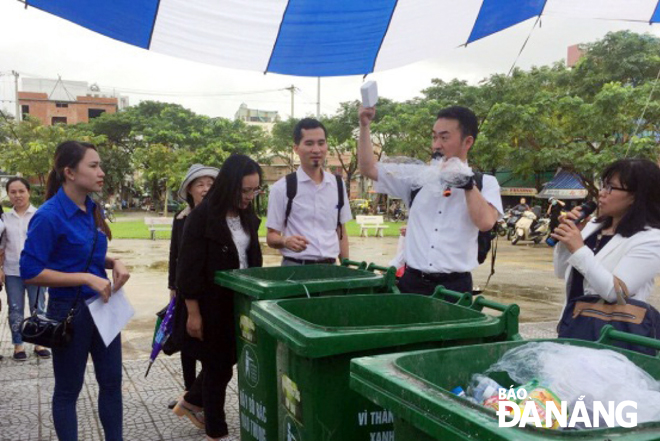Urgent need to sort trash at source
Over the past decade, Da Nang has promoted the garbage classification at the source, and the recycling of solid waste. However, the recycling rate is currently only 10%, much lower than the target of 50-70% set by the city.
 |
| Over recent years, many local women have been actively involved in sorting trash at the source |
In the context of the Khanh Son Landfill in Lien Chieu District’s Hoa Khanh Nam Ward is expected to be full by 2020, and the city is seeking an optimal waste-to-energy technological solution, the waste classification at the source is now an urgent need.
With the help of Yokohama City in Japan and the Japan International Cooperation Agency (JICA), in August 2017, the municipal People's Committee approved a plan to implement the pilot waste classification at the source in the wards of Thuan Phuoc and Thach Thang, both in Hai Chau District over the 2017-2018 period, and work started in November 2017.
A group of employees from relevant agencies took a joint trip to Yokohama which has 25 years of experience in waste classification. Besides, Yokohama experts also came to residence areas in the 2 wards above to guide inhabitants how to classify garbage at the source in appropriate manner.
The waste classification movement was then launched in the wards of Hoa Cuong Bac and Hoa Thuan Tay in Hai Chau District.
The Hoa Thuan Tay Ward Women’s Union has appealed for residents to collect and clean already-used nylon bags in order for them to be then sent to the headquarters of the ward’s authorities for proper treatment, instead of throwing them into dustbins for final disposal at the Khanh Son landfill as previously. These nylon bags are swapped for vegetables and lovely environmentally friendly items.
Such meaningful activity aims at raising public awareness of the harmful impacts of plastic waste on the environment, encouraging them to consume biodegradable products, and promote the classification of trash right at families into 3 types - organic, inorganic, and recycled.
In March 2018, the movement was expanded into the 9 remaining wards of the districts.
After one year of waste classification, a total of over 1 billion VND has been generated from 3-R (reduce, reuse and recycle) programmes conducted in 13 wards in the downtown district.
 |
| Japanese experts guiding inhabitants in Hai Chau District how to classify garbage at the source in appropriate manner |
Meanwhile, in March 2018, the Centre of Environment and Community Research (CECR) launched the ‘Plastic Free Ocean - a Solid Waste Recycling, Classification and Collection Programme for Health Community and Green City’ project in Da Nang.
Funded by the US Agency for International Development (USAID), the project is now underway in Son Tra and Thanh Khe districts from March 2018 to April 2019.
The project aims to develop a waste classification system based on community, encourage residents to recycle and reuse plastic waste, enhance the city’s solid waste management capacity, and help to reduce plastic pollution in the ocean.
In Son Tra District, the project is piloting in residential areas in the wards of An Hai Dong, An Hai Tay, Nai Hien Dong, and Tho Quang.
In addition, the Tho Quang Ward authorities, the district’s Natural Resources and the Environment Office and CECR are together implementing the ‘Collection of rubbish at home’ and ‘Green Houses, Green Gates’ models in the residential area Thanh Vinh 4.
The city has set a target of collecting 95% of solid waste for treatment over the 2019 – 2025 period, with 12% and 15% to be recycled and reused in 2020 and 2025 respectively.
The city expects to expand the waste classification at source initiative across the city by 2022. In the 2021-2022 period, solid waste in the city will be classified into 4 categories: recyclable waste, such as paper, plastic and metal; toxic waste, such as batteries and light bulbs; construction waste; and other types of waste.